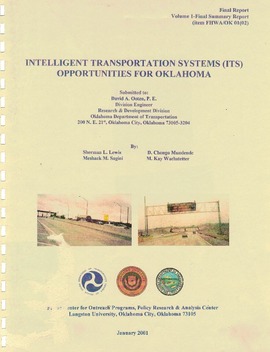| dc.description.abstract | The U.S. Department of Transportation, through the Transportation Equity Act for the 21 st Century (TEA-21), and its predecessor, the Intermodal Surface Transportation Efficiency Act (!STEA), have encouraged research, deployment, and integration ofITS technologies that have led to the implementation offaster, smoother, and cost-effective strategies . Some states have taken advantage of these acts and successfully developed and implemented statewide strategic plans. This study looked at the potential for applying the Intelligent Transportation Systems (ITS) in Oklahoma using advanced sensor, computer, electronics, and communications technologies and management strategies. The study aimed at identifying and summarizing ITS programs, activities, and opportunities at national, regional, state, and local levels of government; identifying existing resources and ITS related goals in Oklahoma; and providing a strategy, identifying resources, constraints, potential barriers, and recommendations for addressing potential barriers in Oklahoma. A survey was conducted in Oklahoma among potential stakeholders for the implementation ofITS. These stakeholders represented Federal/State transportation, public safety/emergency, cities/ municipalities, private/academia, and public nonemergency/ non-transportation entities. ITS technologies exist in Oklahoma that have been individually deployed, especially in the two biggest metropolitan areas: Oklahoma City and Tulsa. Oklahoma is one of the leaders in electronic toll payments through the PikePass. Most ITS technologies are used in emergency and traffic systems. Knowledge on the potential benefits of ITS is limited. A need exists to educate senior level managers , policymakers, decision makers, and the general public about the benefits ofITS. A statewide strategic plan is needed consisting of key stakeholders who could assist in developing the Oklahoma ITS Architecture and help in deploying and integrating ITS technologies . A Transportation Center to do research, analyze, and disseminate ITS information, as well as a management center are urgently needed. Regional cooperation among the bordering states would enhance commercial vehicle operations. | |
